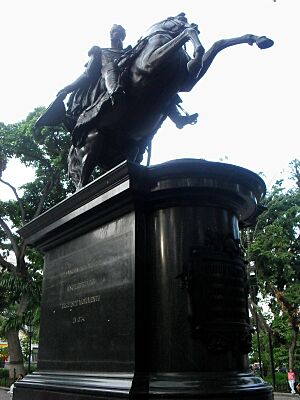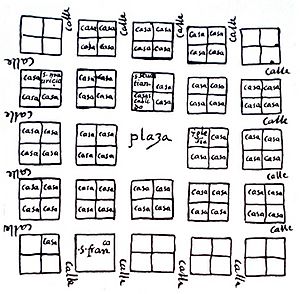Bolívar Square (Caracas) facts for kids

Bolívar Square (which is Plaza Bolívar in Spanish) is a really important and well-known public space in Caracas, Venezuela. It's right in the middle of the oldest part of Caracas. This area was part of the first 25 blocks when the city was started way back in 1567. You can find it in the historic center of the city, in the Cathedral Parish of the Libertador Municipality.
Many important buildings are around Bolívar Square. These include the Caracas Cathedral, the Sacred Museum, the Archbishop's Palace, and the City Hall. You'll also see the Chapel of Santa Rosa de Lima, the Yellow House, the Main Theater, and the building for the Capital District Government. The Federal Legislative Palace is also nearby, to the southwest.
History of Bolívar Square
This spot was planned to be the main square, or Plaza Mayor, of Caracas right from the start. It was meant to be a busy trading center for the town. Over many centuries, the square changed quite a bit. A big change happened in 1754 when Governor Felipe Ricardos ordered arcades (covered walkways) to be built around it.
The square was also a place where people who went against the Spanish colonial government were punished. A famous event was the punishment of José María España in 1799. This square also played a huge role in Venezuela's independence. On April 19, 1810, a popular uprising against the Spanish rule began here. This was the first step towards Venezuela becoming a free country.
Even though it's a very famous place, it's not the biggest square in Venezuela. The Plaza Bolívar in Maracay, Aragua state, is actually larger. It's the biggest in Venezuela and even in Latin America!
After Venezuela became independent, the square had different names. It was called Plaza de Armas (Arms Square) and Plaza del Mercado (Market Square). But in 1842, when the body of Simón Bolívar was brought to Caracas from Santa Marta, it was officially named Plaza Bolívar. However, people didn't really start using that name regularly until 1874.
In 1865, General Antonio Guzmán Blanco became president. He decided to make big changes to the square. In May, he had the arcades around the square taken down and the market vendors moved. Five years later, plans began to fix up the area. A major renovation started in 1872, giving the square a French style. President Blanco also decided to put up a statue of Bolívar in November of that year.
They also planned to add flower beds and plant trees. The four corners of the square were designed to represent the four seasons: spring, summer, autumn, and winter. Each corner got a decorative iron fountain. About 100 iron posts with different decorations were installed, and metal railings were placed around the square's edge. A small set of stairs in the southeast part of the square gave that corner its name, Gradillas, which means "small terrace corner."
The Famous Statue
The statue of Simón Bolívar was officially opened on November 7, 1874. Bells rang and 21 guns were fired to celebrate! This statue, located in the center of the square, is a copy of one made by Adamo Tadolini. The original is in the Bolívar Square in Lima, Peru.
The statue was made by the Von Müller Foundry. It shows Bolívar riding a horse that is standing on its back legs. The statue is supported by a two-level base and stands 4 meters (about 13 feet) tall.
In 1894, electricity was installed in the square. After that, not much changed until 1967, when the colorful original floor was replaced with gray marble. From 1908 to 1947, several stops for the old Caracas tram system were located at the corners of the square.
On February 21, 1959, the statue was officially recognized as a memorial. In 2003, the Libertador Municipality started a full restoration of the square. This included fixing the gardens, fountains, flooring, and lighting.
Image gallery
See also
 In Spanish: Plaza Bolívar de Caracas para niños
In Spanish: Plaza Bolívar de Caracas para niños





